Menus
- BMW R 80 G / S and Honda XLV 750 R in comparison
- BMW R 80 G / S in detail
- Honda XLV 750 R in detail
- Strengths and weaknesses
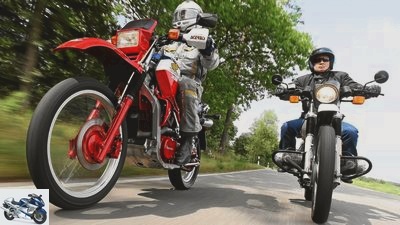
Jahn
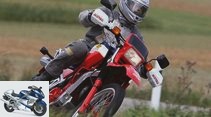
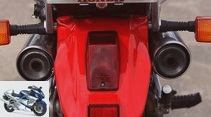
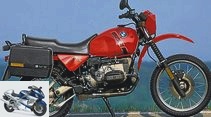
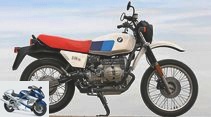
23 photos
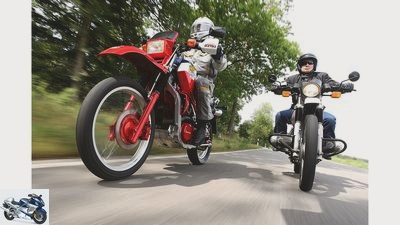
Jahn
1/23
Cruising through the country without hectic: You don’t always have to go rally-style over off-road slopes.
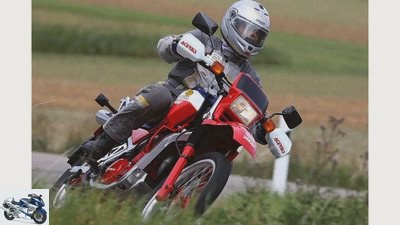
Jahn
2/23
The 220 kilogram XLV is not that unwieldy, but the high center of gravity gives it a somewhat idiosyncratic curve behavior.
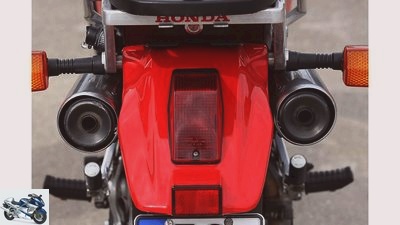
Jahn
3/23
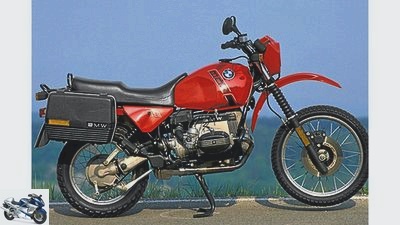
Jahn
4/23
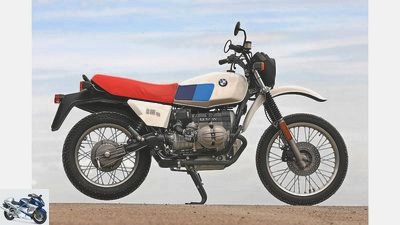
Jahn
5/23
Complete view of the BMW R 80 G / S.
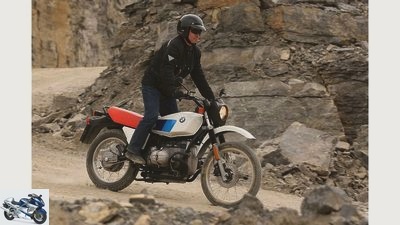
Jahn
6/23
The G / S is well suited for off-road activities, but it is almost too good to take it properly and dust it or cover it with mud.
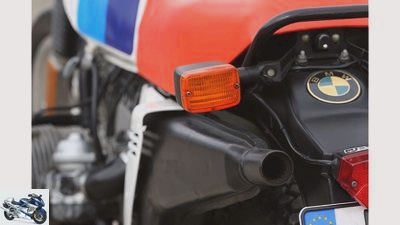
Jahn
7/23
The G / S exhaust pipe, which is positioned upwards on the left, emits a discreetly sporty boxer sound, but proves to be prone to rust.
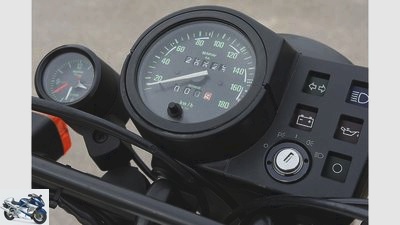
Jahn
8/23
Round thing? The speedometer and indicator lights of the XLV 750 R are easy to read, while the time clock or tachometer (not in the picture) were once optional extras.
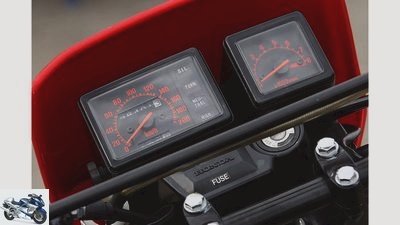
Jahn
9/23
The equipment of the Honda (cockpit, headlights) presents itself in an angular design, after all with a standard rev counter.
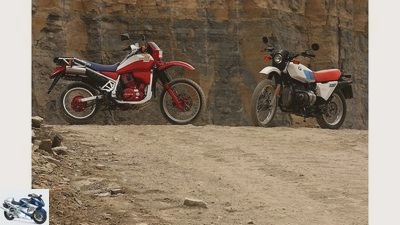
Jahn
10/23
Encounter between the two rivals: the BMW R 80 G / S and Honda XLV 750 R..
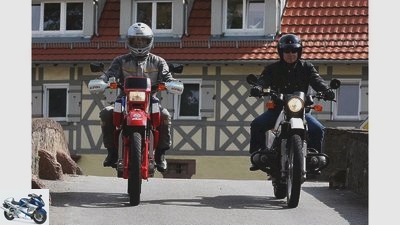
Jahn
11/23
Two chairs, one opinion: Enduros also need two cylinders for true happiness.
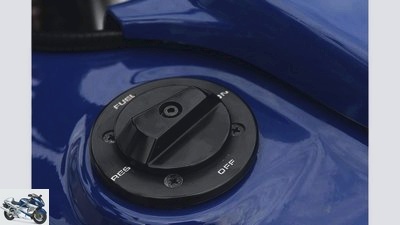
Jahn
12/23
Curious but practical: the fuel tap on the top of the left tank flank of the XLV 750 R..
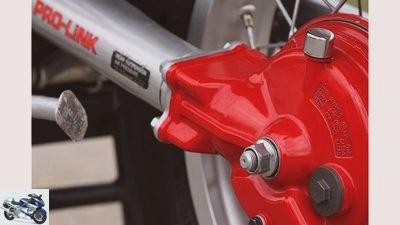
Jahn
13/23
The small, ineffective drum brake of the Honda in fiery red.
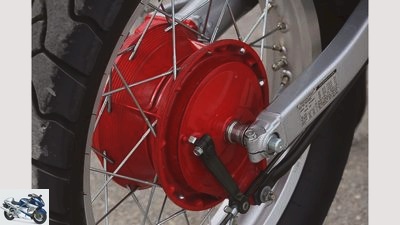
Jahn
14/23
Play of colors: Even the exposed oil filter of the Honda XLV 750 R shines in brilliant red.
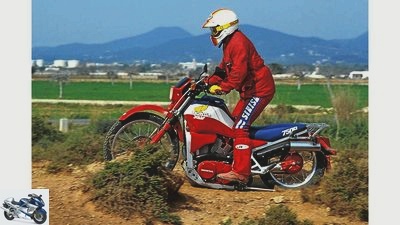
Jahn
15/23
The first comparison of the XLV with the G / S led to such images and painful criticism. Today the Honda is over it.
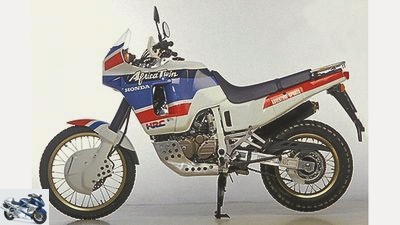
Jahn
16/23
The XRV 650 Africa Twin.

Jahn
17/23
Complete view of the Honda XLV 750 R.
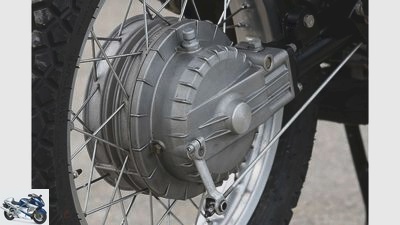
Jahn
18/23
The single-sided swing arm including the cardan tunnel makes it easier to remove the wheel on the BMW R 80 G / S.
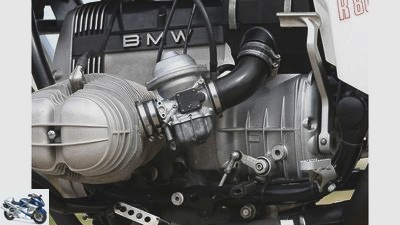
Jahn
19/23
The boxer, which pushes powerfully from below, shines with great smoothness, provided the Bing carburettors are properly adjusted. The BMW is started with an electric or kick starter.
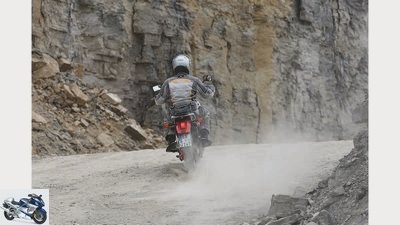
Jahn
20/23
Throws up a lot of dust: the Honda easily masters steep climbs on loose ground. And at every biker get-together she is the star.
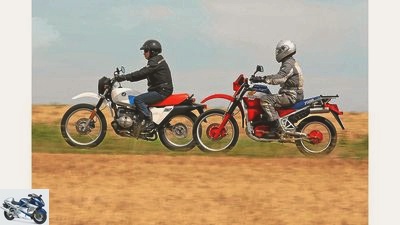
Jahn
21/23
BMW R 80 G / S and Honda XLV 750 R in comparison.
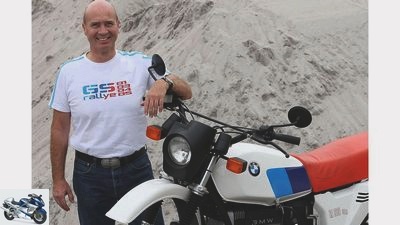
Jahn
22/23
Uwe Metzinger on the BMW R 80 G / S.

Jahn
23/23
Stefan knows about the Honda XLV 750 R.
BMW R 80 G / S versus Honda XLV 750 R – the giants exchange blows
BMW R 80 G / S and Honda XLV 750 R in comparison
They look like winning machines from the Paris-Dakar rally. Around thirty years ago, however, they were the pioneers in travel enduros with their large-capacity twins. A new edition of the giants’ exchange of blows.
Not everyone has the chance to win the legendary Paris-Dakar Rally (now only Dakar Rally). Most of them won’t even cross a desert in their lifetime – but owners of a BMW R 80 G / S or Honda XIn the saddle of their large enduro, LV 750 R at least enjoy the feeling that they could if they wanted. And the companions underpin this with their appearance in the factory racer look. The Honda in particular is not stingy with charms, which earned it ridicule and malicious remarks from the start that it was just a show vehicle. With the large-displacement two-cylinder engines, the two thickest Enduros at the beginning of the 1980s are in any case well armed in terms of performance. In terms of chassis, at least the Honda has a certain handicap with it – 220 kilograms are not a stick on hard terrain. The BMW is significantly lighter with its full tank of 196 kilograms and also proves to be the more off-road rally replica in other ways. A tough terrain test or material-destroying digging through deep sand is not on the program today. Rather, in the course of a comparison trip, the aim is simply to find out what the fascination and attraction of the two opponents is, who once met for the first exchange in 1983 under the motto elephant meeting.
Encounter of the old rivals
The two top-preserved icons would also be a shame to properly flay through the site. The BMW, for example, has just come out of the workshop, where the exhaust pipe of the otherwise sparkling clean 1981 model was freshly painted before the facelift. Uwe Metzinger only bought G / S about a year ago, adding a jewel to his BMW collection. In this condition and with low mileage, G / S copies are rare and sought-after. He has already been offered 15,000 euros, according to Metzinger. Does the driving impression keep what the good condition promises? The start-up procedure is already promising good news. The choke, which has meanwhile moved to the left handlebar fitting, only needs to be activated briefly with the thumb, at the push of a button and with a typical full blow, the starter brings the boxer to life. After a short shake and two or three bursts of gas, the choke aid can be dispensed with and the 800 bubbling obediently to itself. Incidentally, the electric starter was initially optional and subject to a surcharge, but since it was ordered by almost all customers, it was part of the Kickstarter as standard from 1982.
Jahn
Encounter between the two rivals: the BMW R 80 G / S and Honda XLV 750 R..
You sink deep into the soft bench, the ergonomics are almost perfect. The Magura handlebar is not too wide and pleases with optimal offset. The close-fitting notches and the brake and shift levers located far inside appear a bit unusual at first, but with the freedom they provide, make sense at the latest when the G / S driver chases the BMW around the bends at a brisk pace. First of all, however, it is noticeable that the very big cracking of the gearbox does not occur when engaging first gear, and shifting through to fifth is never associated with inappropriate noises.
It is wonderful how spontaneously and brawny the boxer pushes from low revs. If you keep it within its comfort range, i.e. always over 2000 tours, the initial shaking turns into an astonishingly cultivated run in the middle range. The joy of the Boxer is increased by the spontaneity with which it revs up when the throttle flaps of the Bing carburettors are opened with a strong twist on the stiff throttle grip. Various changes to the basic engine of the R 80/7 (see box), including the reduced flywheel mass, lead to this effect, although the revving ability decreases noticeably from around 6000 rpm. The single-disc dry clutch is extremely easy to operate, and the 800 also falls loosely in an inclined position. Thanks to the low center of gravity, thanks to the boxer, the G / S is one of the handiest hijackers ever. The Bavarians recognized this and then added the road version R 80 ST in 1982, with shortened spring travel and road tires and 19-inch instead of 21-inch -Front wheel. To make it clear that the R 80 G / S should not be a competitive offshoot of the factory racer, BMW always emphasized that the abbreviation G / S stands for off-road / road, and not for off-road / sport.
Jahn
The G / S is well suited for off-road activities, but it is almost too good to take it properly and dust it or cover it with mud.
Sporty driving on the road is part of the Bavarian’s domain. The possible lean angles are only limited by the grip of the tires, the R 80 can be thrown from one corner to the next without great effort, whereby the cardan drive running in the specially developed Monolever single-sided swing arm still has to manage without torque support and consequently clear reactions when load changes shows. In order to prevent the rear end from sagging when taking off the accelerator or hardening rear end when accelerating, a round driving style should be practiced. Shift down in good time before the curve, turn in and pull around the corner – if you internalize this, you will have a lot of fun with the BMW thanks to its clean front wheel and stable driving behavior. Even the solo disc of the Brembo brake in the front wheel decelerates properly, albeit without an overly prominent pressure point. A second disc, as suggested by critics in 1981, would have clearly overwhelmed the grip of the studded tires, BMW announced at the time. The fork, twisting when decelerating hard, could have been made more stable with a strut. In addition, you can hardly blame the soft, balanced coordination of the spring elements. At most, the mono-shock absorber appears to be too soft when subjected to tougher loads and rough road conditions.
When the Honda was presented in Ibiza, the chassis was initially heavily criticized. A better chassis was desired for the great engine. Honda reacted, revised the XLV up to the delivery of the series bikes and changed the steering head, increased caster and wheelbase in favor of better straight-line stability. This meant that they thought they were well on their way to finally being able to stand up to the BMW despite its image advantage by winning the Paris-Dakar in 1981. After all, in contrast to the G / S, which is more conventionally constructed (apart from the single-sided swing arm), the XLV contains a lot of innovative technology, shrill packed in the colorful rally outfit mentioned above. Owner Stefan Wisst bought the well-maintained 1984 model driven here in 1986 for a sale price of 9200 marks. He uses his bike both for extended tours with friends and in everyday life. Today he makes them available for comparison. The driver doesn’t sag as much on the slightly higher bench seat, feels much higher up than on the BMW and takes a peculiarly passive stance, especially because of the footrests placed far forward, the knees spread wide by the wide tank flanks and the wide remote handlebar.
Jahn
The 220 kilogram XLV is not that unwieldy, but the high center of gravity gives it a somewhat idiosyncratic curve behavior.
The big V2 starts at the push of a button and is immediately noticeable due to its inconspicuousness. No rough V2 sound, no pithy vibrations – pure running culture. The hydraulic clutch only needs a little manual force, the once scolded, allegedly gnarled and only shiftable with a loud crack turns out to be a pleasant five-speed box. Hard, yes, but honest and direct. The criticism at the time was clearly exaggerated, at least on this point. The three-valve engine increases speed gently and smoothly, does not deliver the full thump of the (also quite briefly translated) BMW around the bottom and jerks rather unwillingly up to 2000 rpm, but grabs cleanly over it, puts it a little on from 6000 rpm and turns lively, albeit without a real bite, towards 8000 rpm. A gentle giant that accelerates the XLV to over 170 km / h when required and hardly vibrates. But even at a brisk country road speed of a good 120 things, the Honda shows its somewhat maudlin side. To compensate, it should be said that the BMW is no better at this either. Normally quick swinging through alternating curves demands a little more concentration with the Honda than with the Bavarian, the XLV cannot deny its high weight, but above all its high center of gravity, it tends to collapse from a certain angle. So it’s better to brake before the next tight bend. Oops, the front single disc looks toothless even when the lever is pulled hard. In addition to the adequate bite, a committed driving style also misses a clear pressure point that would make the dosage easier. The rear drum is of no help. So control your pace and enjoy the inconspicuous working cardan, which shows almost no load change reactions. Well done.
Jahn
Two chairs, one opinion: Enduros also need two cylinders for true happiness.
Comfortable travel giant
There is calm on board even on bad roads, the mighty 43 fork and the Pro Link system iron out almost everything that the XLV gets under the wheels of holes and waves. More and more, the 750 is turning out to be a very comfortable touring machine, which with its 20 liter tank (which looks like a lot more) enables decent ranges and outlines the Honda more as a long-distance bike than an off-road speedster. Last but not least, the standard, stable luggage rack indicates this. The XLV should never and never wanted to win races on the cross slopes of this world. It was a passable travel enduro (with an emphasis on travel) as early as 1983, when this genre was basically just being invented. So maybe it was simply ahead of its time with its numerous innovative technical features. The Honda focuses on long-distance travel, the BMW on the brisk ride over the bumpy home route.
And the desert? With a few modifications, both machines would surely be ready for this immediately if the driver cares. What was the motto of the French Thierry Sabine, founder of the Paris-Dakar Rally: If your life bores you, risk it. You don’t have to go that far right away. It might be enough to simply buy an R 80 G / S or XLV 750 R..
BMW R 80 G / S in detail
Jahn
Complete view of the BMW R 80 G / S.
(1980-1987)
Price 1980: 8,920 marks
Data (Type 0346)
Engine:
Air-cooled two-cylinder four-stroke boxer engine, camshaft below, two valves per cylinder, actuated via bumpers and rocker arms, displacement 797 cm³, output 37 kW (50 PS) at 6500 rpm
Power transmission:
Single-disc dry clutch, five-speed gearbox, cardan drive
Landing gear:
Double loop frame made of steel, telescopic fork in front,
Ø 36 mm, single-sided swing arm, central spring strut, tires 3.00 – 21 front, 4.00 – 18 rear, disc brake front, Ø 260 mm, drum brake rear, Ø 200 mm
Measurements and weight:
Wheelbase 1465 mm, weight with a full tank 196 kg
Vmax: 161 km / h
technology
The series production of a street-legal BMW off-road motorcycle has a long history. It required a great deal of persuasion and determined supporters of the idea. Ultimately, the “Range Rover on two wheels” was created on the basis of already existing, in some cases heavily modified parts. The basic engine of the R 80/7 was used, but with a reinforced housing, improved oil circuit and a lighter flywheel. Instead of the centrifugally cast bushings, the cylinders received a Galnical coating. The advantages: weight saving of almost three kilograms, high wear resistance, improved thermal load capacity and lower oil consumption. The boxer was also given an electronic ignition and, to reduce noise, a new air filter housing with a plate air filter. Handwork also had to be done in the exhaust area: the manifolds lead into a front silencer under the gearbox, the rear silencer was raised and moved to the top left. On the frame, also from the BMW shelf, only a mount for the mono spring strut had to be attached. The clearly visible and perhaps most spectacular innovation was the single-sided swing arm, which also houses the cardan. It not only makes it easier to remove the wheel (only three screws have to be loosened), but also saves two kilograms in weight with 30 percent higher torsional rigidity. In the autumn of 1981 the G / S got a wider rear wheel rim, a modified master brake cylinder and a tighter, more comfortable seat. In 1982, the rust-prone black chrome-plated exhaust system was improved, and models from December 1984 onwards can be run on unleaded petrol thanks to specially hardened exhaust valve seats.
Checkpoints
There are hardly any model-specific problems with the G / S, rather the usual points that apply to most two-valve box models must be observed. The starters sometimes cause problems – the installation of a cheaper, more powerful part from Valeo is popular. The alternators are also frequently affected by failures. Replacement is expensive, so be careful if the indicator light does not go out. Sweating cylinder base gaskets are almost normal, if you can already see it dripping somewhere, you should investigate the cause. A leaking crankshaft oil seal must be replaced – an expensive repair. There are already delivery problems with spare parts, so the rear wheel is not always available, and crankshaft main bearings are also subject to delivery problems. Two-valve guru Siebenrock is now offering the red bench as a replica.
market
Of the 21,864 R 80 G / Ss built, not all are likely to have survived, but most of them are now in collectors’ hands and one is rarely offered. The prices depend heavily on condition and mileage. Even hobbyist vehicles with high mileage are hardly less than 5,000 euros, good specimens cost around 8,000, and top bikes cost more than 10,000 euros. But by no means always paid.
Specialists
Parts
www.vorholt-klein-bmw.de
Uli’s motorcycle shop, Frankfurt am Main, phone: 0 69/23 93 19,
www.ulismotorradladen.de
Parts and repairs
MTS, Landau,
Telephone: 0 63 41/96 90 59-6,
www.mts-motorradtechnik.de
Siebenrock GmbH, Wendlingen, phone: 0 70 24/46 88 10,
www.siebenrock.com
Clubs and forums
www.gs-forum.eu
www.boxer-forum.de
www.2-ventiler.de
history
1987: The R 80 GS replaced the G / S and came up trumps with the Paralever swing arm, which prevents the cardan reactions. From 1990 with frame fixed cladding. Price: 10,950 marks
Honda XLV 750 R in detail
Jahn
Complete view of the Honda XLV 750 R.
(1983-1986)
Price 1984: 10 026 marks
Data (Type RD 01)
Engine:
Air-cooled two-cylinder four-stroke 45-degree V-engine, one overhead camshaft, three valves per cylinder, operated by rocker arms, displacement 749 cm³, output 45 kW (61 hp) at 7000 rpm
Power transmission:
Multi-disc oil bath clutch, five-speed gearbox, cardan drive
Landing gear:
Double loop frame made of steel, telescopic fork at the front, Ø 43 mm, two-arm swing arm with Pro Link system and central spring strut, tires 90/90 S 21 at the front, 130/80 S 17 at the rear, disc brake at the front, Ø 280 mm, double-piston caliper, drum brake at the rear, Ø 140 mm
Measurements and weight:
Wheelbase 1480 mm, weight with a full tank of 220 kg
Vmax: 174 km / h
technology
Filled with special technical features, Honda entered the XLV 750 R in 1983 in order to be able to compete, or better still, dominate the high-displacement two-cylinder enduros. The drive selected was the 45-degree V2 from the VT 750 C, a cruiser that was primarily tailored to the American market. For use in the XLV, however, the water cooling was dispensed with, the cylinders were instead given lush cooling fins and air ducts for the rear cylinder. Inside there is sophisticated technology: three valves per cylinder ensure the gas exchange, plus double ignition, hydraulic valve clearance compensation and offset crank pins to improve the smoothness and reduce vibrations. Another innovation is the use of the cardan drive on a Honda Enduro, which shines thanks not least to the long swing arm with low drive reactions. In addition, the beams integrate
of the square steel tube frame is the oil reservoir for the dry sump lubrication, the rear wheel is guided by a two-arm swing arm with a Honda Pro Link system. To prevent the rear wheel from stamping when downshifting hard, Honda equipped the XLV with an anti-hopping clutch as early as 1983. The XLV 750 R in HRC colors (blue / white / red) with the addition “D” showed off its red painted motor, fork bars and wheel hubs. The “F” version, revised for 1985 (tamer camshafts, only 55 HP, improved timing chain tensioner, modified carburetor tuning) with a black engine and tamer paint variants was not offered in Germany, but mainly sold in France, Italy and Australia.
Checkpoints
Especially with the red engines, bearing damage can occur (carefully check the oil level), the short-lived timing chain tensioners need to be kept in mind, gear damage has also been reported, in the form of gears jumping out due to worn shift forks (especially fourth gear). There are no longer any new parts, so it is difficult to obtain replacements. Temperature-related problems can also be observed, especially with defective alternators. Usually a defective ignition coil is to blame if a cylinder fails completely. Poor throttle response and a hole in the partial load range of the “D” model when the engine is hot may be due to the long vent hose of the carburetor – the installation of the short hose of the “F” model should help. New parts are already rare, help and tips can be found in the forums, especially among XLV drivers. Such as tire tips (Mitas E-07, very durable, or the Bridgestone BT 45 for pure road drivers).
market
In Germany, used XLVs, which were already poorly sold as new vehicles, are now rare. Only about 200 of them are still roaring around in this country, some more will probably still be shut down in sheds or garages. It is advisable to expand your search to Switzerland or even France, where you can still find good specimens. The prices are still astonishingly humane, ready-to-drive XLVs with signs of use and higher mileage are available from 2000 euros, even bikes that are cared for with few kilometers rarely cost more than 3500 euros.
Specialists
Parts
Biker deals
Telephone: 0 51 52/52 49 28
www.bikerdeals.de
Clubs and forums
www.xlv750.de
www.xlv.ch
history
1988: The XRV 650 Africa Twin is considered the legitimate successor. Your 52-degree V2 engine delivers 50 (open 57) hp and drives the rear wheel again via chain. Price: 10,570 marks
Strengths and weaknesses
| BMW R 80 G / S | Honda XLV 750 R. | |
| technology | ||
| reliability | 7/10 | 7/10 |
| Driving behavior | 8/10 | 7/10 |
| Performance | 7/10 | 8/10 |
| Suitability for everyday use | 7/10 | 8/10 |
| Repair friendliness | 9/10 | 6/10 |
| market | ||
| Availability | 4/10 | 2/10 |
| demand | 8/10 | 4/10 |
| Spare parts supply | 5/10 | 3/10 |
| Used price level | 7/10 | 4/10 |
| Value forecast | 8/10 | 6/10 |
| emotion | ||
| Driving fun | 8/10 | 7/10 |
| Sound | 7/10 | 6/10 |
| character | 7/10 | 7/10 |
| design | 7/10 | 8/10 |
| Cult potential | 9/10 | 7/10 |
Jahn
Uwe Metzinger on the BMW R 80 G / S.
Uwe Metzinger on the BMW R 80 G / S
The basic R 80 G / S complements my small collection of Paris-Dakar models (R 80 G / S and R 100 GS) perfectly and is extremely fun with its great handiness. It is moved regularly, but not too many kilometers are added. I am getting it in top condition and I think it will definitely increase in value over the next few years.
Jahn
Stefan knows about the Honda XLV 750 R.
Stefan knows about the Honda XLV 750 R
I bought my 1984 XLV new in 1986 when hardly anyone wanted it and the prices fell sharply. Since then, I’ve been moving them normally in everyday life and on extended tours, so far without any major problems. For me, a beautiful, reliable and, above all, comfortable everyday companion with a great engine, but bony gear.
Related articles
-
Comparison test: Honda CX 500-650 Turbo, Kawasaki Z 750 Turbo, Suzuki XN 85, Yamaha XJ 650 Turbo
Jahn 21st photos Jahn 1/21 The preload of the central spring strut of the Suzuki can be easily adjusted. Jahn 2/21 Thanks to the 16-inch front wheel, the…
-
Comparison test of the sports tourers from BMW and Honda
fact 12th photos fact 1/12 Top brakes: radially screwed six-piston stoppers, ABS and integral actuation. fact 2/12 Builds compact and very narrow: the…
-
Comparison test travel enduros
Jahn Comparison test of travel enduros, BMW R 1200 GS Adventure, KTM 990 Adventure, Moto Guzzi Stelvio Travel enduros Their martial look promises…
-
Comparison test touring enduro bikes: Honda Transalp, Kawasaki Versys, Suzuki V-Strom 650
Jahn Comparison test of travel enduro bikes: Honda Transalp, Kawasaki Versys, Suzuki V-Strom 650 Always along the wall Travel enduro doesn’t necessarily…
-
Enduro comparison – off-road bikes from Beta, Honda, Yamaha and KTM
Monnich 24 photos Monnich 1/24 With the Freeride 350, KTM is taking responsibility for the off-road scene. The competition: Yamaha WR 250 R, Honda CRF…
-
Comparison test of supersports: Honda CBR 600 F, Kawasaki ZX-6R, Suzuki GSX-R 600, Yamaha YZF 600 R
Comparison test of supersports: Honda CBR 600 F, Kawasaki ZX-6R, Suzuki GSX-R 600, Yamaha YZF 600 R Let’s twist again Wake up people. In the 600s it’s…
-
ABS comparison: BMW F 650 GS-BMW R 1200 GS; Honda CBF 600-Honda VFR-ABS
fact ABS comparison: BMW F 650 GS / BMW R 1200 GS; Honda CBF 600 / Honda VFR-ABS Two-class society BMW and Honda offer their customers much cheaper…
-
Comparison test BMW K 1200 RS against Honda CBR 1100 XX
Comparison test BMW K 1200 RS against Honda CBR 1100 XX Crown jewels K 1200 RS and CBR 1100 XX are the image carriers of BMW and Honda. You don’t just…
-
Comparison test all-rounder Honda Hornet 900, Triumph Speed Triple, Yamaha FZS 1000 Fazer
Comparison test all-rounder Honda Hornet 900, Triumph Speed Triple, Yamaha FZS 1000 Fazer Free radicals Uncovered, light and strong: Honda Hornet 900….
-
Comparison test: Honda Varadero 125, Kawasaki KMX 125, MZ 125 SX, Yamaha TDR 125
Comparison test: Honda Varadero 125, Kawasaki KMX 125, MZ 125 SX, Yamaha TDR 125 The upper floors Power from the cellar cannot be made with a…